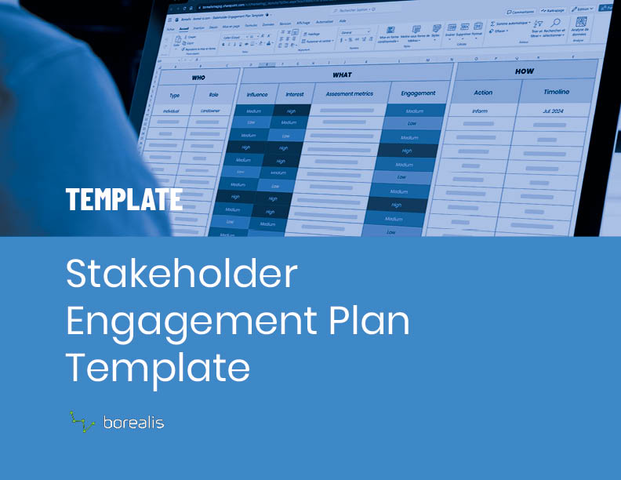Benefits of senior stakeholder engagement and satisfaction
Some senior stakeholders will be effusive allies, while others may openly resist or even oppose your project.Because of their outsized impact, knowing how to manage senior stakeholders and building rapport, trust and credibility with them are vital to project success.
Senior stakeholder support is not only desirable nice-to-haves, but they’re also strategic must-haves. Because of their unique knowledge set and experience, senior stakeholders can often improve project quality, help course-correct project direction when things go off the rails and even mitigate risks. They can also provide invaluable feedback and assist you in achieving your project goals by tapping into their vast networks to secure just-in-time resources or adding their influence or endorsements to key negotiations or outcomes.
An eight-step plan to manage senior stakeholders
Step 1: Identify your senior stakeholders
The first step to successful senior stakeholder management is identifying who might be significantly impacted by your project or business, or how they could affect its outcome. You’ll want to consider both internal and external stakeholders in this process and initially create as exhaustive a list as possible.
Reviewing organizational charts will help you discover individuals or departments to add to your internal stakeholder list, but you’ll also want to speak directly with supervisors, managers and employees to get a boots-on-the-ground perspective.
When it comes to identifying external stakeholders, a lot will depend on the type of project you’re managing. If your project has potential community impacts, residents in the area will be key stakeholders, as will community leaders, local government officials and regulatory bodies. Company shareholders will always be high-priority stakeholders, as will relevant social media influencers, activists and media personnel.
Step 2: Do a deeper dive with stakeholder analysis
Once you’ve identified your stakeholders, you’ll want to know more about them, including things like:
- Their needs, interests and expectations
- Area of expertise (if any)
- What role they typically play in projects
- Their current perception of your company or project
- Their level of power and influence
- Who influences them
- The risks they represent to the project
- What constitutes value for them
- How they measure success
- Their engagement and communication preferences
- Etc.
Thorough stakeholder analysis will help you pinpoint those with senior status so you can create an informed engagement strategy that reduces opposition, increases buy-in and creates the best possible outcomes for everyone involved.
An excellent strategy for supporting this step is to create a centralized stakeholder register as you identify stakeholders. This database of stakeholder should be easily accessible and located centrally, enabling all team members involved in stakeholder identification to contribute to and access the information. This centralized method helps prevent the loss of important data and avoids the creation of isolated lists that contain different amounts of information.
Step 3: Prioritize your stakeholders
Once you know more about them, you can use a classic two-by-two matrix or stakeholder mapping solution to prioritize senior stakeholders based on attributes such as power and interest in your project to allocate your resources more efficiently.
For example, you might decide to monitor the feedback from low-power/low-interest senior stakeholders but aim to keep low-power/high-interest stakeholders regularly informed about project initiatives and milestones via a monthly newsletter.
You would make significant efforts to manage, engage, involve and satisfy senior stakeholders in the high-power/high-interest category and also look to satisfy high-power/low-interest senior stakeholders who could quickly move into the high-power/high-interest quadrant if they felt slighted.
However, it’s important to note: without proper prioritization, stakeholders with lower influence, who may have frequent concerns, may monopolize stakeholder management time and resources.
Step 4: Manage senior stakeholders' needs and expectations
Managing senior stakeholders’ needs and expectations can be daunting due to unrealistic or conflicting expectations or the desire to implement changes beyond the budget or scope of the project.
It’s crucial to set SMART objectives, milestones and deliverables (specific, manageable, achievable, realistic and timely) at the beginning of the project and control scope creep by constantly documenting and analyzing how senior stakeholders’ proposed or negotiated changes are impacting the project’s budget and timeline.
You’ll also want to ensure managing certain groups of senior stakeholders doesn’t cause you to neglect the needs of others or divert your attention from vital project tasks.
This is where the use of structured data and dashboards becomes highly beneficial. Being able to access live data on engagement activities, the groups involved, and the milestones achieved can be a game changer. This approach ensures that teams and managers can adapt strategies in real-time, eliminating the need to spend days or weeks compiling data.
Step 5: Build trust and rapport by communicating regularly and effectively
Keeping senior stakeholders informed of project status, progress, and risks is important, as is acknowledging their concerns and providing timely feedback. You should also be open and honest about changes, challenges, or compromises that may affect program outcomes or stakeholder interests.
Your communication plan should outline the purpose, frequency, format and channels you’ll use for various updates to ensure senior stakeholders receive information in ways best suited to them. Many will prefer email communication. Some may favor video conferencing. Others might want face-to-face debriefs.
You’ll also want to tailor your message for different senior stakeholder groups. For instance, you’ll likely use more formal, concise and data-driven language for government regulators or senior executives and more engaging, story-based language for resident groups or leaders of tribal communities.

Creating a solid stakeholder engagement plan is crucial for effective project management.
Step 6: Seek senior stakeholders' input and feedback
Step 7: Resolve conflicts constructively and collaboratively
Effective conflict resolution creates a culture of respect, encourages open communication, and ultimately bonds parties together with trust.
By knowing how to deal with stakeholder conflict, liaison officer, project manager and external affairs specialist can simultaneously enhance stakeholder relationships, cement their reputation as reliable and fair process adjudicators and preserve project harmony and progress.
Step 8: Deliver value to your senior stakeholders
It’s essential to remain aware of what constitutes value for elders and senior stakeholders throughout the project’s lifecycle.
For example, understanding and delivering value to the leaders of a tribal community is a critical aspect throughout the project’s lifecycle. In the initial planning phase, value for a respected elder or leader might include involving them in discussions related to cultural or environmental aspects of the project, areas where their wisdom and experience are deeply valued. As the project progresses to completion, demonstrating value could involve honoring these leaders in a significant role during a community celebration or ceremony, acknowledging their contributions and influence in the success of the project.
You can check to see if you’ve delivered value by revisiting your original stakeholder analysis work and scoring your engagement strategies and tactics against the needs and expectations originally identified for your senior stakeholders. You can also examine various interactions and communications stored in the database of your community engagement software.
When stakeholders feel valued and appreciated, they’re more likely to contribute their expertise and resources productively, leading to increased opportunities for growth and minimized project interventions or delays in the future.
How to manage senior stakeholders with a fit-for-purpose tool
Building rapport, credibility, trust and buy-in with senior stakeholders is essential for project success.
Although senior stakeholders are a category in their own right, with their own challenges, it is important to recognize that these individuals often possess multiple roles or attributes beyond their seniority. This diversity can make managing communication, expectations, and arising issues more complex. Therefore, the need for a fit-for-purpose stakeholder relationship management tool becomes crucial in effectively handling these complexities.
Over our 20 years of operation, we have assisted more than 200 companies in structuring their stakeholder engagement data, enhancing team efficiency and project outcomes. Our software is designed to aid engagement professionals in identifying and categorizing their stakeholders, planning their activities, tracking interactions with stakeholders, and evaluating the impact of their initiatives. Access to real-time data ensures that everyone involved is informed and aligned, facilitating more effective stakeholder management and decision-making processes.





